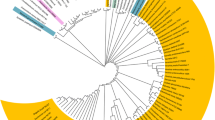Abstract
Functional and structural characterizations of pyridoxal 5′-phosphate-independent aspartate racemase of the acidothermophilic archaeon Picrophilus torridus were performed. Picrophilus aspartate racemase exhibited high substrate specificity to aspartic acid. The optimal reaction temperature was 60 °C, which is almost the same as the optimal growth temperature. Reflecting the low pH in the cytosol, the optimal reaction pH of Picrophilus aspartate racemase was approximately 5.5. However, the activity at the putative cytosolic pH of 4.6 was approximately 6 times lower than that at the optimal pH of 5.5. The crystal structure of Picrophilus aspartate racemase was almost the same as that of other pyridoxal 5′-phosphate -independent aspartate racemases. In two molecules of the dimer, one molecule contained a tartaric acid molecule in the catalytic site; the structure of the other molecule was relatively flexible. Finally, we examined the intracellular existence of d-amino acids. Unexpectedly, the proportion of d-aspartate to total aspartate was not very high. In contrast, both d-proline and d-alanine were observed. Because Picrophilus aspartate racemase is highly specific to aspartate, other amino acid racemases might exist in Picrophilus torridus.





Similar content being viewed by others
Abbreviations
- PtoAspR:
-
Aspartate racemase of Picrophilus torridus
- TFA:
-
Trifluoroacetic acid
- NBD-F:
-
4-Fluoro-7-nitrobenzofurazan
- PLP:
-
Pyridoxal 5′-phosphate
References
Adams PD, Afonine PV, Bunkoczi G, Chen VB, Davis IW, Echols N, Headd JJ, Hung LW, Kapral GJ, Grosse-Kunstleve RW, McCoy AJ, Moriarty NW, Oeffner R, Read RJ, Richardson DC, Richardson JS, Terwilliger TC, Zwart PH (2010) PHENIX: a comprehensive Python-based system for macromolecular structure solution. Acta Crystallogr D Biol Crystallogr 66(Pt 2):213–221. doi:10.1107/S0907444909052925
Chen VB, Arendall WB 3rd, Headd JJ, Keedy DA, Immormino RM, Kapral GJ, Murray LW, Richardson JS, Richardson DC (2010) MolProbity: all-atom structure validation for macromolecular crystallography. Acta Crystallogr D Biol Crystallogr 66(Pt 1):12–21. doi:10.1107/S0907444909042073
Emsley P, Lohkamp B, Scott WG, Cowtan K (2010) Features and development of Coot. Acta Crystallogr D Biol Crystallogr 66(Pt 4):486–501. doi:10.1107/S0907444910007493
Futterer O, Angelov A, Liesegang H, Gottschalk G, Schleper C, Schepers B, Dock C, Antranikian G, Liebl W (2004) Genome sequence of Picrophilus torridus and its implications for life around pH 0. Proc Natl Acad Sci USA 101(24):9091–9096. doi:10.1073/pnas.0401356101
Kawakami R, Ohmori T, Sakuraba H, Ohshima T (2015) Identification of a novel amino acid racemase from a hyperthermophilic archaeon Pyrococcus horikoshii OT-3 induced by d-amino acids. Amino Acids 47(8):1579–1587. doi:10.1007/s00726-015-2001-6
Klingl A (2014) S-layer and cytoplasmic membrane—exceptions from the typical archaeal cell wall with a focus on double membranes. Front Microbiol 5:624. doi:10.3389/fmicb.2014.00624
Liu L, Iwata K, Yohda M, Miki K (2002) Structural insight into gene duplication, gene fusion and domain swapping in the evolution of PLP-independent amino acid racemases. FEBS Lett 528(1–3):114–118
Long Z, Lee JA, Okamoto T, Sekine M, Nimura N, Imai K, Yohda M, Maruyama T, Sumi M, Kamo N, Yamagishi A, Oshima T, Homma H (2001a) Occurrence of d-amino acids and a pyridoxal 5′-phosphate-dependent aspartate racemase in the acidothermophilic archaeon, Thermoplasma acidophilum. Biochem Biophys Res Commun 281(2):317–321. doi:10.1006/bbrc.2001.4353
Long Z, Nimura N, Adachi M, Sekine M, Hanai T, Kubo H, Homma H (2001b) Determination of d- and l-aspartate in cell culturing medium, within cells of MPT1 cell line and in rat blood by a column-switching high-performance liquid chromatogrpahic method. J Chromatogr B Biomed Sci Appl 761(1):99–106
Matsumoto M, Homma H, Long Z, Imai K, Iida T, Maruyama T, Aikawa Y, Endo I, Yohda M (1999) Occurrence of free d-amino acids and aspartate racemases in hyperthermophilic archaea. J Bacteriol 181(20):6560–6563
Morris GM, Huey R, Lindstrom W, Sanner MF, Belew RK, Goodsell DS, Olson AJ (2009) AutoDock4 and AutoDockTools4: automated docking with selective receptor flexibility. J Comput Chem 30(16):2785–2791. doi:10.1002/jcc.21256
Ohtaki A, Nakano Y, Iizuka R, Arakawa T, Yamada K, Odaka M, Yohda M (2008) Structure of aspartate racemase complexed with a dual substrate analogue, citric acid, and implications for the reaction mechanism. Proteins 70(4):1167–1174. doi:10.1002/prot.21528
Okada H, Yohda M, Giga-Hama Y, Ueno Y, Ohdo S, Kumagai H (1991) Distribution and purification of aspartate racemase in lactic acid bacteria. Biochim Biophys Acta 1078(3):377–382
Otwinowski Z, Minor W (1997) Processing of X-ray diffraction data collected in oscillation mode. Methods Enzymol 276:307–326
Radkov AD, Moe LA (2014) Bacterial synthesis of d-amino acids. Appl Microbiol Biotechnol 98(12):5363–5374. doi:10.1007/s00253-014-5726-3
Schleper C, Puhler G, Kuhlmorgen B, Zillig W (1995) Life at extremely low pH. Nature 375(6534):741–742. doi:10.1038/375741b0
Staudenbauer W, Strominger JL (1972) Activation of d-aspartic acid for incorporation into peptidoglycan. J Biol Chem 247(16):5095–5102
Winn MD, Ballard CC, Cowtan KD, Dodson EJ, Emsley P, Evans PR, Keegan RM, Krissinel EB, Leslie AG, McCoy A, McNicholas SJ, Murshudov GN, Pannu NS, Potterton EA, Powell HR, Read RJ, Vagin A, Wilson KS (2011) Overview of the CCP4 suite and current developments. Acta Crystallogr D Biol Crystallogr 67(Pt 4):235–242. doi:10.1107/S0907444910045749
Yamauchi T, Choi SY, Okada H, Yohda M, Kumagai H, Esaki N, Soda K (1992) Properties of aspartate racemase, a pyridoxal 5′-phosphate-independent amino acid racemase. J Biol Chem 267(26):18361–18364
Yohda M, Okada H, Kumagai H (1991) Molecular cloning and nucleotide sequencing of the aspartate racemase gene from lactic acid bacteria Streptococcus thermophilus. Biochim Biophys Acta 1089(2):234–240
Yohda M, Endo I, Abe Y, Ohta T, Iida T, Maruyama T, Kagawa Y (1996) Gene for aspartate racemase from the sulfur-dependent hyperthermophilic archaeum, Desulfurococcus strain SY. J Biol Chem 271(36):22017–22021
Yoshida T, Seko T, Okada O, Iwata K, Liu L, Miki K, Yohda M (2006) Roles of conserved basic amino acid residues and activation mechanism of the hyperthermophilic aspartate racemase at high temperature. Proteins 64(2):502–512. doi:10.1002/prot.21010
Acknowledgments
We are grateful to the beamline assistants at the Photon Factory (PF) for data collection at the beamlines BL-5A, BL-6A and AR-NW12.
Author information
Authors and Affiliations
Corresponding author
Additional information
Communicated by H. Atomi.
Rights and permissions
About this article
Cite this article
Aihara, T., Ito, T., Yamanaka, Y. et al. Structural and functional characterization of aspartate racemase from the acidothermophilic archaeon Picrophilus torridus . Extremophiles 20, 385–393 (2016). https://doi.org/10.1007/s00792-016-0829-7
Received:
Accepted:
Published:
Issue Date:
DOI: https://doi.org/10.1007/s00792-016-0829-7




